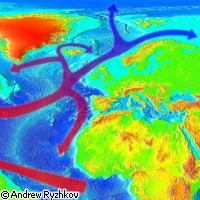The answer to changing currents lies in the wind
In the Age of Sail, knowledge of the world's ocean currents was a must. They controlled the fortunes of sailors and whole nations. Now a collaborative study between Spanish and German researchers has discovered for the first time how small variations in surface winds significantly changed the ocean currents of the North Atlantic. These changes may have been responsible for the abrupt climate change that occurred during the last glacial period. A joint research study between the Complutense University of Madrid (UCM) Spain, and the Potsdam Institute for Climate Impact Research in Germany has received special mention from the American Geophysical Union. Their research has been published in the prestigious journal Geophysical Research Letters. As a result of the research conducted by the scientists, small alterations in sea winds have been identified as critical factors in the abrupt change in climate that occurred during the last glacial period. The root cause for the last glacial period has as yet to be determined and completely understood. Marisa Montoya and Anders Levermann were the researchers who carried out the study. Together, the researchers have concluded that there is a precise point, a tipping point if you will, from which a small variation in the speed of sea winds corresponds to a dramatic change in the Atlantic circulation intensity. 'If the glacial climate had been in the vicinity of that point, small wind changes could have caused sudden and significant climatic changes during that period,' said Marisa Montoya. The researchers based their study on climatic simulations called Last Glacial Maximum (LGM). This refers to the period of time when the ice sheets reached their maximum extent, en event that occurred over 21,000 years ago. This period lasted for several thousand years and covered the whole of Iceland, and with the exception of the southernmost tip, the whole of the United Kingdom, the whole of Northern Europe. Based on their simulations, they have been able to positively demonstrate the existence of a tipping point, which once reached, even the smallest changes in wind speed causes disproportionately large changes in the speed of the sea currents. What this means is that changes in wind speed have had an important role in the abrupt climatic change of the last ice age. Creating climate simulations of the Last Glacial Maximum is one of the most important challenges for experts in this area. Now these simulations are able to be cross-referenced with climatic reconstructions based on data gathered from natural elements, such as sea sediments or the oldest ice samples. Thanks to these simulations, all climatic models previous made can be evaluated in a method that does not include the same parameters and conditions used in their design. The results achieved by the model also confirm the relevance of small variations and help further substantiate the hypothesis regarding the physical mechanisms responsible for the climatic changes as observed in the reconstructions. Now scientists have both the climatic simulations as well as the reconstructions at their disposal, both of which indicate that variations in the Atlantic Ocean circulation could have been the key mechanism responsible for the abrupt climatic change that took place over the ice age.
Countries
Germany, Spain



